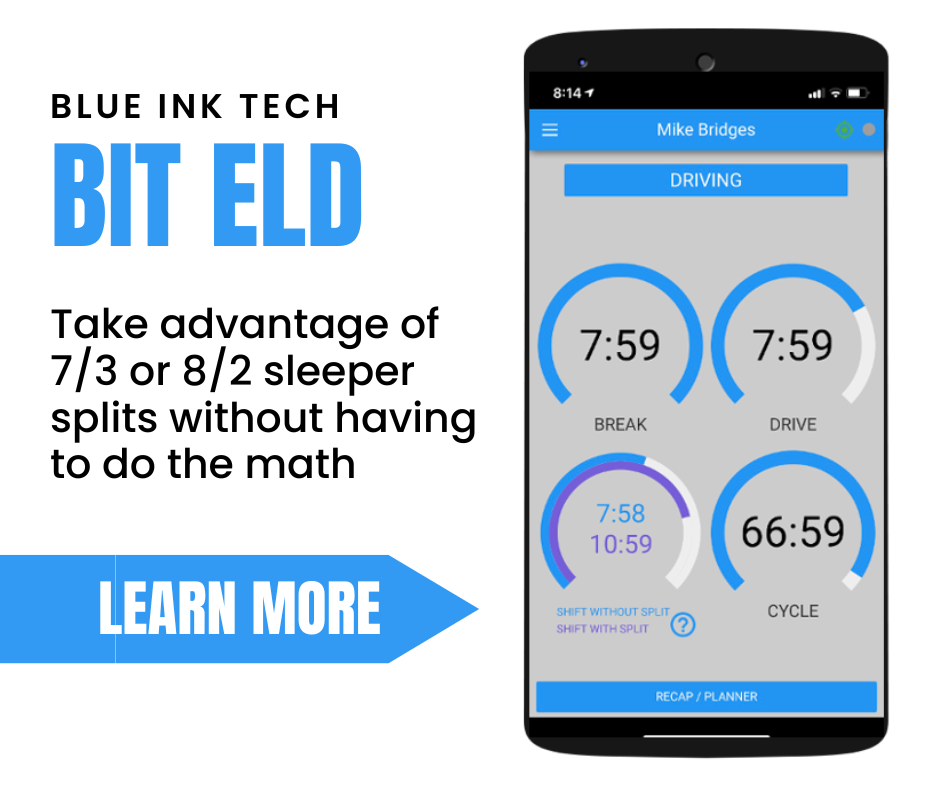The sleeper berth split provision is one of the most complicated events to use in the hours or service regulation. A sleeper berth split can allow you to get more out of your 14 hour driving window but it must be performed correctly or else you can get place out-of-service for not having enough rest.
On June 1, 2020, the FMCSA revised the HOS regulations on driving limits for commercial motor vehicle drivers after many comments, as well as additional data and information they obtained. Drivers, like Rob, now have more ways to remain compliant while still maintaining the FMCSA’s safety standards.
What is the sleeper berth split?
The sleeper split rule allows a driver to split their required 10 hour reset across 2 separate periods with one being a time of sleep for 7-8 hours.
Before the revision, a driver had to spend a minimum of 8 hours in the sleeper berth and it was excluded from the 14-hour work window. The other 2(+) hours of additional rest time a driver had to take was included in the 14-hour window.
Starting September 29, 2020, the split rule was updated. Drivers now have options for time logged for sleeper berth. While it must always equal at least 10 hours, drivers can use a split-time. This is to give drivers more flexibility if they run into unexpected situations.
A driver may use a 7/3-split (sleeper berth for 7 hours, 3 hours off-duty) or an 8/2 split (sleeper berth for 8 hours, off-duty for 2 hours). Commodity drivers are still prohibited from driving more than 11 hours inside the 14 hour window.
What are the split sleeper berth rules?
To do a sleeper split a driver must have a period of at least 7 hours on the sleeper berth in their logs and a period of at least 2 hours in either off duty or sleeper berth. These 2 breaks must add up to 10 hours to be properly qualified as a split sleeper.
A common misconception is that the a sleeper split must start with the first break period being in the sleeper berth status, however, this is not the case. As long as the 2 periods add up to 10 hours and the longer period is a sleeper berth status of at least 7 hours, this can be considered a sleeper split. You can look at the sleeper split as a 7/3, 8/2, 2/8, or 3/7.
When a sleeper split is properly executed and there are 2 periods adding up to 10 hours in the logbook then the "calculation point" of where the 14 hour clock starts shifts. The new calculation point will begin at the end of the first break taken. Below is an example of a sleeper split logbook:
Rob is going to extend his 14-hour driving window using his sleeper berth. Time spent in the sleeper berth does not count against your 14-hour clock.
- 1 a.m. he leaves for the shipper
- 7 a.m. he arrives and goes off duty waiting for his load window (3 hours)
- 10 a.m. he is ready to get loaded.
- 11 a.m. he gets loaded, secures the load, and signs paperwork
- 11 a.m. he starts driving to his delivery point
- 3 p.m. he takes his 7 hour sleeper to finish his 7/3 split
- 10 p.m. his split is complete and he can calculate his new 14 hour window starting from the end of his off duty event.
- He can now work until 7 a.m before his new 14 hour clock end allowing him to get up to 3 more driving hours in his day.
How to use the split sleeper berth
Situations happen all of the time in the trucking industry that may prevent a driver from getting the most out of their 14 hour day. One of the biggest problems blamed on ELDs is the loss of time is spent at shippers and receivers waiting to get loaded or unloaded.
Using the 8/2 split or 7/3 split can help drivers account for these long wait times and extend their 14 hour driving windows with a shorter sleeper berth period instead of trying to do a full 10 hour reset. In this situation Rob can get 3 more hours in his 14 hour window which could mean up to 150 additional miles in the day.
During long wait times, if drivers are told there is going to be a wait then drivers can move to off-duty and fulfill the 2-3 hours needed to complete a full sleeper split. (This is only if a driver is not responsible for the truck and can freely leave to eat or walk around.)
After loading, the driver can continue their route to where their original 14 hour window would end. At this point, instead of taking a full 10 hours to reset their clock they can take 7-8 hours instead and recalculate their 14 hour window starting at the end of the 2-3 hour off-duty event.
The sleeper split rule is not often used because of its confusing nature. Using a well developed ELD can help drivers better understand when to take advantage of this rule and get the most miles out of their 14 hour days.

